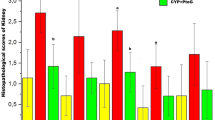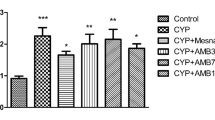Abstract
Purpose
Hemorrhagic cystitis (HC) is the most common urotoxic side effect of cyclophosphamide (CP). The aim of this study was to compare the classical efficacy of mesna (2-mercaptoethane sulfonate sodium) with three different doses of resveratrol (RES) on cyclophosphamide-induced HC in rats.
Methods
Forty-six male Sprague–Dawley rats were divided into six groups. Group 1 served as a negative control (sham). Five groups received a single dose of cyclophosphamide (150 mg/kg) intraperitoneally at the same time. Groups 2, 3, 4, 5, and 6 received only CP, CP + 20 mg/kg RES, CP + 40 mg/kg RES, CP + 80 mg/kg RES, and CP + classical protocol of three doses of mesna (30 mg/kg three times), respectively. Antioxidants, cytokines, and malondialdehyde levels were measured in all groups. In addition, histopathological alterations in tissues were examined.
Results
CP administration induced severe HC with marked edema, hemorrhage, and inflammation in group 2. RES 20 mg/kg showed meaningful protection against bladder damage compared to the control group. It was seen that RES 40 mg/kg gave weaker protection but RES 80 mg/kg was not found to be effective.
Conclusion
In conclusion, marked bladder protection was found in 20 and 40 mg/kg RES applications compared to the control group, but this protection was weaker than with mesna.





Similar content being viewed by others
References
Levine LA, Richie JP (1989) Urological complications of cyclophosphamide. J Urol 141:1063–1069
Kranc DM, Kim J, Straus F, Levine LA (1992) Prophylactic and therapeutic carboprost tromethamine bladder irrigation in rats with cyclophosphamide-induced hemorrhagic cystitis. J Urol 148:1326–1330
Levine LA, Jarrard DF (1993) Treatment of cyclophosphamide-induced hemorrhagic cystitis with intravesical carboprost tromethamine. J Urol 149:719–723
Chow YC, Yang S, Huang CJ, Tzen CY, Huang PL, Su YH et al (2006) Epinephrine promotes hemostasis in rats with cyclophosphamide-induced hemorrhagic cystitis. Urology 67:636–641
Assreuy AM, Martins GJ, Moreira ME, Brito GA, Cavada BS, Ribeiro RA et al (1999) Prevention of cyclophosphamide-induced hemorrhagic cystitis by glucose–mannose binding plant lectins. J Urol 161:1988–1993
Wong TM, Yeo W, Chan LW, Mok TS (2000) Hemorrhagic pyelitis, ureteritis, and cystitis secondary to cyclophosphamide: case report and review of the literature. Gynecol Oncol 76:223–225
West NJ (1997) Prevention and treatment of hemorrhagic cystitis. Pharmacotherapy. 17:696–706
Traxer O, Desgrandchamps F, Sebe P, Haab F, Le Duc A, Gattegno B et al (2001) Hemorrhagic cystitis: etiology and treatment. Prog Urol 11:591–601
Batista CK, Brito GA, Souza ML, Leitão BT, Cunha FQ, Ribeiro RA (2006) A model of hemorrhagic cystitis induced with acrolein in mice. Braz J Med Biol Res 39:1475–1481
Manikandan R, Kumar S, Dorairajan LN (2010) Hemorrhagic cystitis: a challenge to the urologist. Indian J Urol 26:159–166
Korkmaz A, Topal T, Oter S (2007) Pathophysiological aspects of cyclophosphamide and ifosfamide induced hemorrhagic cystitis; implication of reactive oxygen and nitrogen species as well as PARP activation. Cell Biol Toxicol 23:303–312
Kehrer JP, Biswal SS (2000) The molecular effects of acrolein. Toxicol Sci 57:6–15
Monach PA, Arnold LM, Merkel PA (2010) Incidence and prevention of bladder toxicity from cyclophosphamide in the treatment of rheumatic diseases: a data-driven review. Arthritis Rheum 62:9–21
Dechant KL, Brogden RN, Pilkington T, Faulds D (1991) Ifosfamide/mesna. A review of its antineoplastic activity, pharmacokinetic properties and therapeutic efficacy in cancer. Drugs 42:428–467
Hensley ML, Schuchter LM, Lindley C, Meropol NJ, Cohen GI, Broder G et al (1999) American Society of Clinical Oncology clinical practice guidelines for the use of chemotherapy and radiotherapy protectants. J Clin Oncol 17:3333–3355
Brock N, Pohl J, Stekar J (1981) Studies on the urotoxicity of oxazaphosphorine cytostatics and its prevention—I. Experimental studies on the urotoxicity of alkylating compounds. Eur J Cancer 17:595–607
Oboh G, Akomolafe TL, Adefegha SA, Adetuyi AO (2012) Attenuation of cyclophosphamide-induced neurotoxicity in rat by yellow dye extract from root of Brimstone tree (Morinda lucida). Exp Toxicol Pathol 64:591–596
Rehman MU, Tahir M, Ali F, Qamar W, Lateef A, Khan R et al (2012) Cyclophosphamide-induced nephrotoxicity, genotoxicity, and damage in kidney genomic DNA of Swiss albino mice: the protective effect of Ellagic acid. Mol Cell Biochem 365:119–127
Fulda S, Debatin KM (2006) Resveratrol modulation of signal transduction in apoptosis and cell survival: a mini-review. Cancer Detect Prev 30:217–223
Pervaiz S, Holme AL (2009) Resveratrol: its biologic targets and functional activity. Antioxid Redox Signal 11:2851–2897
De la Lastra CA, Villegas I (2007) Resveratrol as an antioxidant and pro-oxidant agent: mechanisms and clinical implications. Biochem Soc Trans 35:1156–1160
Kitada M, Koya D (2013) Renal protective effects of resveratrol. Oxid Med Cell Longev. doi:10.1155/2013/568093
Vieira MM, Macêdo FY, Filho JN, Costa AC, Cunha AN, Silveira ER et al (2004) Ternatin, a flavonoid, prevents cyclophosphamide and ifosfamide-induced hemorrhagic cystitis in rats. Phytother Res 18:135–141
Yildirim I, Korkmaz A, Oter S, Ozcan A, Oztas E (2004) Contribution of antioxidants to preventive effect of mesna in cyclophosphamide-induced hemorrhagic cystitis in rats. Cancer Chemother Pharmacol 54:469–473
Bhatia K, Ahmad F, Rashid H, Raisuddin S (2008) Protective effect of S-allylcysteine against cyclophosphamide-induced bladder hemorrhagic cystitis in mice. Food Chem Toxicol 46:3368–3374
Botta JA Jr, Nelson LW, Weikel JH Jr (1973) Acetylcysteine in the prevention of cyclophosphamide-induced cystitis in rats. J Natl Cancer Inst 51:1051–1058
Jain SK, McVie R, Duett J, Herbst JJ (1989) Erythrocyte membrane lipid peroxidation and glycosylated hemoglobin in diabetes. Diabetes 38:1539–1543
Aebi H (1984) Catalase in vitro. Methods Enzymol 105:121–126
Ooboshi H, Ibayashi S, Shichita T, Kumai Y, Takada J, Ago T et al (2005) Postischemic gene transfer of interleukin-10 protects against both focal and global brain ischemia. Circulation 111:913–919
Sentürk S (2005) Evaluation of the anti-endotoxic effects of polymyxin-E (colistin) in dogs with naturally occurred endotoxic shock. J Vet Pharmacol Ther 28:57–63
Zhang Y, Zhao M, Jin M, Xu C, Wang C, Liu W (2010) Immunotoxicity of pyrethroid metabolites in an in vitro model. Environ Toxicol Chem 29:2505–2510
Song J, Liu L, Li L, Liu J, Song E, Song Y (2014) Protective effects of lipoic acid and mesna on cyclophosphamide-induced haemorrhagic cystitis in mice. Cell Biochem Funct 32:125–132
Sadir S, Deveci S, Korkmaz A, Oter S (2007) Alpha-tocopherol, beta-carotene and melatonin administration protects cyclophosphamide-induced oxidative damage to bladder tissue in rats. Cell Biochem Funct 25:521–526
Sener G, Sehirli O, Yegen BC, Cetinel S, Gedik N, Sakarcan A (2004) Melatonin attenuates ifosfamide-induced Fanconi syndrome in rats. J Pineal Res 37:17–25
Topal T, Oztas Y, Korkmaz A, Sadir S, Oter S, Coskun O et al (2005) Melatonin ameliorates bladder damage induced by cyclophosphamide in rats. J Pineal Res 38:272–277
Sinanoglu O, Yener AN, Ekici S, Midi A, Aksungar FB (2012) The protective effects of spirulina in cyclophosphamide induced nephrotoxicity and urotoxicity in rats. Urology 80:1392–1396
Al-Malki AL (2012) Synergestic effect of lycopene and Melatonin against the genesis of oxidative stress induced by cyclophosphamide in rats. Toxicol Ind Health 30:570–575
Yuan ZM, Smith PB, Brundrett RB, Colvin M, Fenselau C (1991) Glutathione conjugation with phosphoramide mustard and cyclophosphamide. A mechanistic study using tandem mass spectrometry. Drug Metab Dispos 19:625–629
Adams JD Jr, Klaidman LK (1993) Acrolein-induced oxygen radical formation. Free Radic Biol Med 15:187–193
Al-Yahya AA, Al-Majed AA, Gado AM, Daba MH, Al-Shabanah OA, Abd-Allah AR (2009) Acacia Senegal gum exudate offers protection against cyclophosphamide-induced urinary bladder cytotoxicity. Oxid Med Cell Longev 2:207–213
Sehirli O, Sakarcan A, Velioğlu-Oğünç A, Cetinel S, Gedik N, Yeğen BC et al (2007) Resveratrol improves ifosfamide-induced Fanconi syndrome in rats. Toxicol Appl Pharmacol 222:33–41
Halliwell B (1996) Antioxidants in human health and disease. Annu Rev Nutr 16:33–50
Zareia M, Shivanandappa T (2013) Amelioration of cyclophosphamide-induced hepatotoxicity by the root extract of Decalepis hamiltonii in mice. Food Chem Toxicol 57:179–184
Oter S, Korkmaz A, Oztas E, Yildirim I, Topal T, Bilgic H (2004) Inducible nitric oxide synthase inhibition in cyclophosphamide induced hemorrhagic cystitis in rats. Urol Res 32:185–189
Korkmaz A, Oter S, Sadir S, Coskun O, Topal T, Ozler M, Bilgic H et al (2005) Peroxynitrite may be involved in bladder damage caused by cyclophosphamide in rats. J Urol 173:1793–1796
Hamsa TP, Kuttan G (2011) Protective role of Ipomoea obscura (L.) on cyclophosphamide-induced uro- and nephro-toxicities by modulating antioxidant status and pro-inflammatory cytokine levels. Inflammopharmacology 19:155–167
Moore KW, O’Garra A, Malefyt RW, Vieira P, Mosmann TR (1993) Interleukin-10. Annu Rev Immunol 11:165–190
Huet O, Laemmel E, Fu Y, Dupic L, Aprico A, Andrews KL, Moore SL, Harrois A, Meikle PL, Vicaut E, Chin-Dusting JP, Duranteau J (2013) Interleukin 10 antioxidant effect decreases leukocytes/endothelial interaction induced by tumor necrosis factor α. Shock 39:83–88
Acknowledgments
This study was supported by the Afyon Kocatepe University Scientific Research Projects Coordination Unit (Project No: 12.TIP.09).
Conflict of interest
None.
Author information
Authors and Affiliations
Corresponding author
Rights and permissions
About this article
Cite this article
Keles, I., Bozkurt, M.F., Cemek, M. et al. Prevention of cyclophosphamide-induced hemorrhagic cystitis by resveratrol: a comparative experimental study with mesna. Int Urol Nephrol 46, 2301–2310 (2014). https://doi.org/10.1007/s11255-014-0833-8
Received:
Accepted:
Published:
Issue Date:
DOI: https://doi.org/10.1007/s11255-014-0833-8




